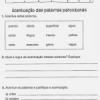
Portuguese activity, suitable for students in the ninth year of elementary school, explores the demonstrative pronouns. How about analyzing the demonstrative pronouns present in the text paper and ink? So, answer the various questions proposed! In “Take That leaf on the table!”, the use of the demonstrative pronoun underlined indicates that the leaf is close to the speaker, is it close to the listener, is it far from the speaker and the listener? Let's go to the challenge?
You can download this Portuguese language activity in an editable Word template, ready to print in PDF and also the completed activity.
Download this Portuguese exercise at:
SCHOOL: DATE:
PROF: CLASS:
NAME:
Read:
One day, a sheet of paper that was on a table with other sheets exactly like it found itself covered with signs. A black pen had written a bunch of words across the sheet.
- Couldn't you spare me this humiliation? - She complained angrily the sheet of paper for the ink.
- Wait! – replied the ink. – I didn't spoil you. I covered you with words. Now you are no longer just a sheet of paper, you are a message. You have turned into a precious document!
The sheet of paper didn't settle for that and was almost crying, feeling dirty and belittled beside the other sheets, all clean and white.
But shortly thereafter, a beautiful girl approached the pile of sheets of paper. He didn't even care for the ones that were blank. She took the one covered with words and held it to her face. She smiled, beautifully, and sighed.
The sheet of paper, if it could have smiled in relief, would have smiled too. Happy, she now understood what the ink had said. Now she was a special sheet of paper, very special!
Adaptation by Pedro Bandeira of the short story by Leonardo Da Vinci Available at:
Question 1 - Underline the demonstrative pronoun that makes up this excerpt:
"The sheet of paper did not conform to this and was almost crying, feeling dirty and diminished next to the other sheets, all clean and white."
Question 2 - The demonstrative pronoun underlined above:
( ) retrieves information.
( ) announces information.
( ) complements information.
Question 3 - The term "a" is a demonstrative pronoun in the passage:
( ) “[…] a table together with other sheets exactly like it […]”
() “She took the one covered with words […]”
( ) “[…] and brought it close to his face.”
Question 4 – In the passage mentioned above, the demonstrative pronoun "a" refers to:
( ) to the beautiful girl.
( ) to the sheet of paper.
( ) to the stack of sheets of paper.
Question 5 - In “– Couldn't you spare me of this humiliation?”, the highlighted word is the contraction of a preposition with the demonstrative pronoun “this”. Tick it:
( ) "in".
( ) "in".
( ) "per".
Question 6 – Reread this period of the text:
"Happy, she now understood what the ink had said."
In the above period, the word "o" performs the function of demonstrative pronoun, as it has the equivalent meaning to:
( ) "that".
( ) "that one".
( ) "that one".
Question 7 – The demonstrative pronoun, identified in the previous question, is:
( ) invariable.
( ) variable in gender.
( ) variable in number.
Question 8 – In the sentence "Take That sheet on the table!", the use of the demonstrative pronoun underlined indicates that the sheet:
( ) is close to the speaker.
( ) is close to the listener.
( ) is far from the speaker and listener.
By Denyse Lage Fonseca
Graduated in Languages and specialist in distance education.
 report this ad
report this ad

